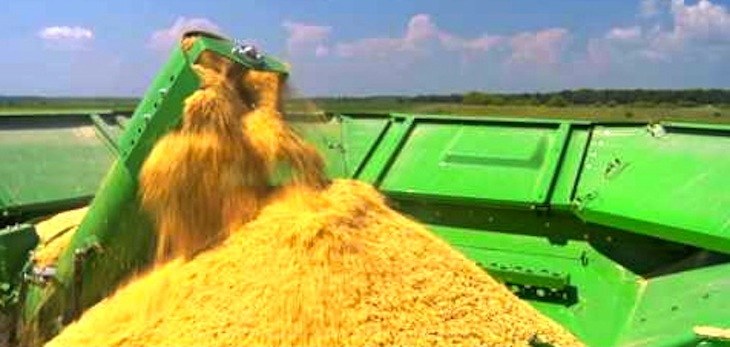Rice yields could be strong if rains subside
by August 20, 2018 4:44 pm 414 views

Arkansas could have a good to excellent rice crop in 2018 if the weather would cooperate, rice agronomist Dr. Jarrod Hardke told Talk Business & Politics. Visual examinations of certain fields point towards yields in the 160 bushels per acre or more range, but constant rains since the middle of last week have halted what should have been the start of the rice harvest, he said.
Parts of Northeast Arkansas, especially in Randolph and Clay counties, have been deluged with rain, and some fields have had 10 inches dumped on them in recent days. If the rains will subside, the negative impacts to the crop will only be minimal at most, he said.
“It’s looking pretty good. We do need a break from the rains. If we can get some sunshine that would be good. We need to get rolling.”
The National Weather Service is predicting strong thunderstorms through the state on Monday (Aug. 20), but a drying pattern is expected to set in during the next week.
Hardke doesn’t think rice yields will approach record setting levels of 168 bushels per acre set in 2013 and 2014, but it could be better than expected based on the drastic weather conditions farmers have battled this year. An unusually cold spring, coupled with intense heat mid-summer caused problems, he said. The rain and wind came in torrents at times this year, but luckily it rained on some days and the high winds came on other days, Hardke said.
When rains and winds combine it can cause rice to “lay down” and it makes it harder to harvest. Kernels that are put under stress have a greater chance of breaking during the milling process. Whole kernels are more valuable, Hardke said.
Arkansas’ rice harvest typically begins in mid-August and runs through the end of September. Rice farmers in the south are the first to harvest and then it gradually spreads to the Northeast corner of the state.
Arkansas farmers were projected to grow 1.4 million rice acres this season, an uptick from 2017 when about 1.161 million acres were planted. It was 47.1% of all rice acres planted in the U.S., according to the B.R. Wells Arkansas Rice Research study issued by the University of Arkansas Division of Agriculture.
Those acres accounted for 82.6 million hundredweight of rice, and it represented 46.4% of the 178.2 million hundredweight produced in the country. During the last three years, Arkansas has accounted for more than 47% of the nation’s total rice production, the report found. Per acre, farmers had a yield of 164.4 bushels per acre or 7,400 pounds. It was the third highest yield on record in the state and a 570 pound per acre uptick from 2016.
Rice is grown in 40 of Arkansas’ 75 counties and is predominately grown in the eastern section of the state. The first rice crop was grown on a single acre in Lonoke County in 1902, although there are reports of the crop in the state before the Civil War, according to historians. Rice acres steadily grew from then and by 1955 the federal government initiated a set of controls capping the number of rice acres at 500,000. Controls were lifted in the 1970s, and the number of rice acres continued to grow. The state set its all-time rice acreage record in 2010 when farmers planted 1.785 million acres.
Another problem for some rice farmers could be a pest, billbugs. About 100,000 rice acres are being grown in rows this year. Billbugs, once an occasional pest of rice that cannot survive in standing water, are putting increased pressure on crops as row rice acreage rises. Billbugs are weevils whose larvae bore into the side of rice tillers, or stems, which deprives developing grain heads of nutrients. This leads to “blank heads,” or heads that never develop kernels. Billbugs cannot survive aquatic conditions, making row rice, which does not hold a continuous flood, an ideal environment.
“We’ve been saying for the last few years as row rice becomes more popular, we’re going to have a billbug problem,” said Nick Bateman, extension rice entomologist for the University of Arkansas System Division of Agriculture. “And there have been some reports over the past couple of years, but this is one of the first years we’ve seen, at least in pockets, a substantial number of billbugs.”
Because billbug larvae bore into the side of rice tillers, most damage isn’t seen until it’s too late. There haven’t been reports of widespread infestations, but as row crop rice farming becomes more popular, it will become more of an issue, Bateman said.
